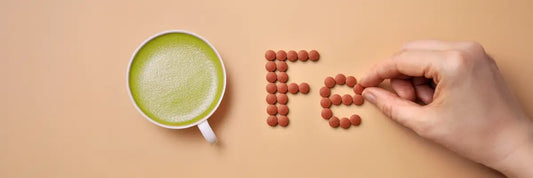With all this hype around matcha, have you ever wondered what's inside matcha?
In this article, we’re going to start by clarifying what’s inside matcha including its chemical components of matcha powder and the potential benefits they can have on our health.
Then we’ll take a deeper dive and talk about what is inside a latte matcha and what impact that can have when it comes to taste, health and more.
Let’s get whisking!
What’s inside matcha

Let’s narrow our focus and talk about what’s inside matcha powder.
Premium matcha powder contains one ingredient: tencha leaves.
These leaves are carefully grown, selected and processed to make the perfect matcha tea.
Let’s quickly go through each step:
From Tencha Leaf to Green Gold
Step #1 - Shade growing

Before the leaves are even picked, the production begins. The farmer will cover the tea plants in a special type of netting 3 weeks before the harvest.
By blocking contact with the sun, the tea leaves will produce less catechins and maintain more theanine. The theanine is what’s inside matcha that makes it so smooth and savory.
Step #2 - Harvesting
Once the shading is complete, the tea leaves will be harvested in early to mid spring. Because the matcha tea plant has had all winter to build up nutrients and it releases those nutrients into the fresh sprouts. These are what’s in matcha that makes it so healthy.
The farmers will pick only the top 3-5 leaves, as these are the youngest and most nutrient dense.
Step #3 - Processing
Almost immediately after harvesting, the farmer will take the leaves and steam them. By applying heat, the enzymes are deactivated and the oxidation process is stopped. This locks in the green color of the leaf and prevents it from turning into a black tea (oxidized tea).
Step #4 - Stem removal
A process unique to matcha is the stem removal. These tougher, yellowish stems are less flavorful and harder to grind, so they need to be removed. Once the stems are removed, the tea leaves are considered tencha and they are one step away from becoming matcha.
That’s what’s in matcha that makes it so smooth and flavorful: all leaves, no stems.
Step #5 - Grinding
To produce premium matcha, the tencha leaves need to be ground in an ishi usu or electric granite mill. These mills can produce an incredibly fine powder between 5-10 microns (smaller than a red blood cell) which creates a luxurious sensation on the palate.
A finer grind means a better flavor extraction, smoother texture and more foam. So it’s not just about what’s inside matcha, but also how it's ground.
What’s inside a matcha latte? The full breakdown
So what’s inside a matcha latte? A typical matcha latte will have 4 main ingredients:
- Matcha powder
- Water
- Milk
- Some type of sweetener.
Let’s go through each one briefly and see what each one contributes to the flavor of the matcha latte:
#1 Matcha Powder
So what’s inside a matcha latte that gives it that green color and exotic flavor? That would be matcha powder, made out of stone ground Japanese tea leaves. This little powder may be the smallest ingredient by volume, but make no mistake, it is the star of the show.
Without this powder, the latte would just be sweet milk and people wouldn’t be lined up around the block to get one.
#2 Water
In general, its best to limit the amount of water in your matcha latte but you will need some water to get things going in your latte. In addition to being mixed into water, matcha also “brews” so it’s important to mix it into a small amount of water before adding the rest of the ingredients.
This will speed up the flavor extraction and lead to a richer flavor in your matcha latte.
#3 Milk
What’s inside a matcha latte can determine everything from the flavor to the calorie content. For example, different milks can have very different flavor profiles. Oatmilk is considered the most neutral, and it’s a classic for matcha lattes.
Almond milk and rice milk are the most “thin” but they can greatly reduce the calories in your matcha latte. These plant milks are what’s inside a matcha latte when it’s vegan. Dairy milk is the most rich in flavor, but also the most calorically dense.
#4 Sweetener
Finally, what’s inside a matcha latte that makes it so sweet? That comes down to the sweetener. There are some great sweeteners like agave, maple syrup, and brown sugar. These are what’s inside a matcha latte when it’s labeled as “vegan”, but honey can also be used in a matcha latte as a sweetener.
What's inside matcha on a chemical level
Now we start to get technical, what’s inside matcha on a chemical level and how does this lead to its many health benefits.
Catechins
Catechins are a major part of what’s inside matcha, and they can lead to the most potent health benefits. These are some of matcha's most prevalent antioxidants, and they are believed to help with everything from weight loss to cold and flu prevention.
To learn more about the health benefits, we suggest you read our guide: Matcha Benefits
Caffeine
What’s inside matcha that gives you that rush of energy? That would be the caffeine. Caffeine is produced by the tea plant as a defense mechanism to protect against insects, and it is very high in matcha.
1 gram of high quality matcha can contains 34mg of caffeine. A typical usucha matcha is made with 1 teaspoon and a large matcha latte is made with 2 teaspoons, giving you 136mg, or more than a small cup of coffee.
Theanine
What’s inside matcha that gives you that clean and calm focus? L-theanine is an amino acid almost unique to the tea plant, and it is believed to buffer some of the negative side effects of caffeine.
It’s thought to induce a calming effect on the brain, which is why tea drinkers report having a long-lasting, calm alert feeling without the crash or jitters associated with coffee.
Chlorophyll
What’s inside matcha that makes it so green? That’s chlorophyll, baby! This is produced by the tea plant to compensate for the lack of sunlight and it can also have some benefits when it comes to health.
Vitamins and Minerals
Finally, there are also vitamins and minerals inside matcha. Matcha provides vitamin K1, vitamin C, and provitamin A (beta-carotene), which support normal blood clotting and bone health, immune function and collagen formation, and healthy vision and skin.
It also supplies minerals like manganese, potassium, and magnesium. Manganese supports antioxidant enzymes and metabolism, potassium helps muscle and nerve function and normal blood pressure, and magnesium contributes to energy production and reduced tiredness.



